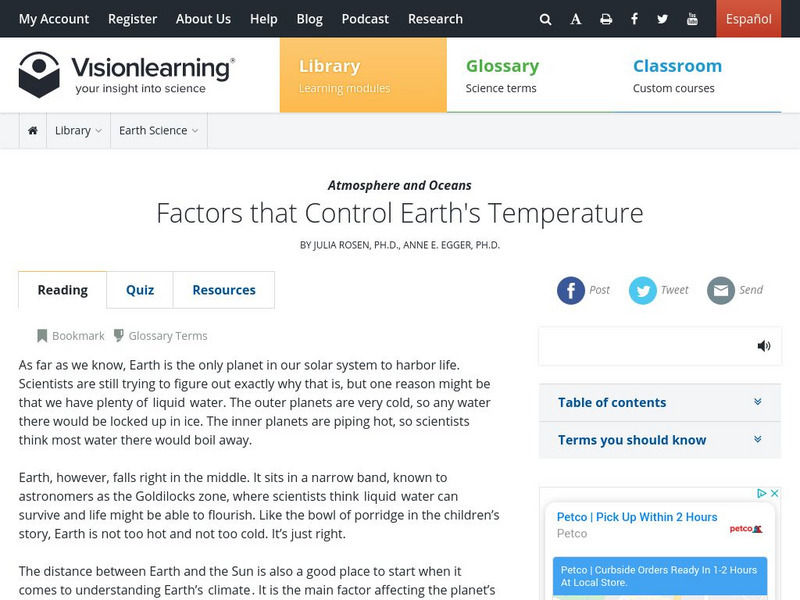Hi, what do you want to do?
ClassFlow
Class Flow: Visible Light and the Electromagnetic Spectrum
[Free Registration/Login Required] This flipchart introduces fifth grade students to the electromagnetic spectrum and focuses on the visible light spectrum, but all types of energy waves in the electromagnetic spectrum are touched on. It...
ClassFlow
Class Flow: Earth Day
[Free Registration/Login Required] This flipchart covers significance and importance of Earth Day. Activities relate to the 3 R's, cleaning up trash, planting trees, conservation of energy and electricity, an acrostic poem, and Earth Day...
Other
Marietta College: Ecosystems
Complete illustrated discussion of energy flow within ecosystems, including discussions of trophic levels, ecological pyramids, food chains and webs, biological magnification, and cycles.
TryEngineering
Try Engineering: Electric Switches
Lesson focuses on how switches control the flow of electricity. Students are posed with the challenge of designing and building a simple switch into an electric circuit.
Science Buddies
Science Buddies: Leaky Clues to Dam Design: How Reservoir Height Affects Hydroel
It's hard to believe that the same water that you use every day to quench your thirst, cook with, bathe in, swim in, and wash your clothes and dishes, is capable of another trick-it can make electricity. Electricity can be generated...
Other
Seeds Foundation: Hydroelectricity
Have you ever tried to walk across a flowing stream? Have you ever watched a news report that showed cars and bridges being washed away by a flood? These experiences and events suggest the force of moving water, which provides a...
TryEngineering
Try Engineering: Flashlights and Batteries
Students work in teams to explore how a flashlight works. This activity examines the topics of batteries, electron flow, circuit systems, switches, and bulbs.
TryEngineering
Try Engineering: Series and Parallel Circuits
The core of this lesson is simple circuits and the differences between parallel and series circuit design. Students perform experiments to test the differences between the two circuit designs using low voltage light bulbs.
Georgia State University
Georgia State University: Hyper Physics: Heat Pump
Heat flow from a hot region to a cold region is described and explained. Applications of this phenomenon (specifically heat pumps and refrigerators) are discussed. Excellent graphics.
Ministry of Education, Sports & Culture (Samoa) Government
Mesc: Samoa School Net: Forces to Make Weather: Weather & Water Cycle
Explains three forces of nature and how they impact the weather. These include infrared rays from the sun, differences in air pressure, and wind flow when hot and cold air masses meet. Supported by lots of visuals.
ClassFlow
Class Flow: Cellular Respiration
[Free Registration/Login Required] This is a comprehensive, engaging overview of catabolic pathways that yield energy by oxidizing organic fuel. Students explore redox reactions, oxidation, reduction, and preview the stages of cellular...
ClassFlow
Class Flow: Heat
[Free Registration/Login Required] This flipchart investigates how heat is produced and the effects of heating and cooling and demonstrates how a change in temperature indicates a change in heat. Students will sequence objects according...
ClassFlow
Class Flow: Geography:resources
[Free Registration/Login Required] A flipchart useful for checking students' understanding of the issues and the vocabulary they need to demonstrate their understanding of the geography resources.
ClassFlow
Class Flow: Chemical Kinetics and Alkane Nomenclature
[Free Registration/Login Required] This flipchart covers essential concepts of factors that affect a chemical reaction and nomenclature of Alkenes.
ClassFlow
Class Flow: Forces Land
[Free Registration/Login Required] This flipchart describes physical characteristics of landforms and bodies of water including mountains, plains, plateaus, valleys, rivers, bays, and lakes.
Ohio State University
Ohio State University: Concepts of Plant Ecology
An advanced discussion of plant interactions and relationships. Energy flow, nutrient cycling and succession are discussed. Try the quiz to check your understanding.
Science Struck
Science Struck: A Bird's Eye View of the Desert Food Chain
Describes how a food chain works in a desert and how the Mojave desert food chain works in particular.
Tom Richey
Slide Share: Ecosystems and You
Slideshow that looks at energy flow in an ecosystem. Explains what an ecosystem is, how energy flows through it, the producers and consumers of energy, and food chains. Links to a video about plastic debris in the ocean.
Concord Consortium
The Concord Consortium: Molecular Workbench: Undershot Water Wheel
View a simulation of water flowing under a wheel that causes the wheel to rotate. Energy from the water is transferred to the wheel.
Massachusetts Institute of Technology
Mit: Open Course Ware: Courses: Civil Environmental: Ecology I: The Earth System
College-level online course highlighting the fundamentals of ecology. Course topics include coevolution of the biosphere, geosphere, atmosphere, and hydrosphere; photosynthesis and respiration; and the carbon, nitrogen, and water cycles....
Vision Learning
Visionlearning: Atmosphere and Oceans: Factors That Control Earth's Temperature
An explanation of how temperature is affected by the composition of the atmosphere and how energy flows in and out of Earth's atmosphere.
Georgia Department of Education
Ga Virtual Learning: Ap Biology: Ecology
Students review the study of living things and make connections back to Earth's systems. This unit focuses on how various species, grouped in populations and communities, work with the nonliving things around them to ensure survival.
TeachEngineering
Teach Engineering: Electrifying the World
This lesson introduces young scholars to the fundamental concepts of electricity. This is accomplished by addressing questions such as "How is electricity generated," and "How is it used in every-day life?" The lesson also includes...
TeachEngineering
Teach Engineering: What Is the Best Insulator: Air, Styrofoam, Foil, or Cotton?
That heat flows from hot to cold is an unfortunate truth of life. People have put a lot of effort into stopping this fact, however all they have been able to do is slow the process. Working in groups of three to four, students will...























